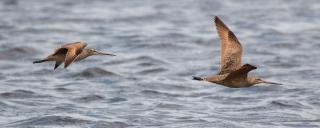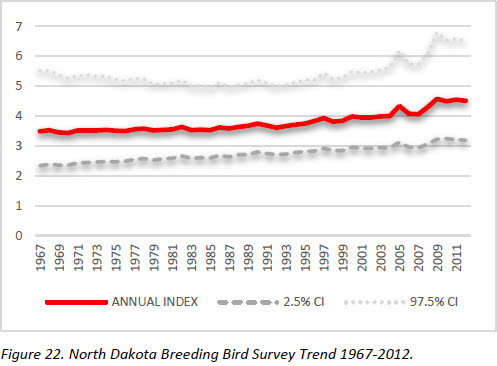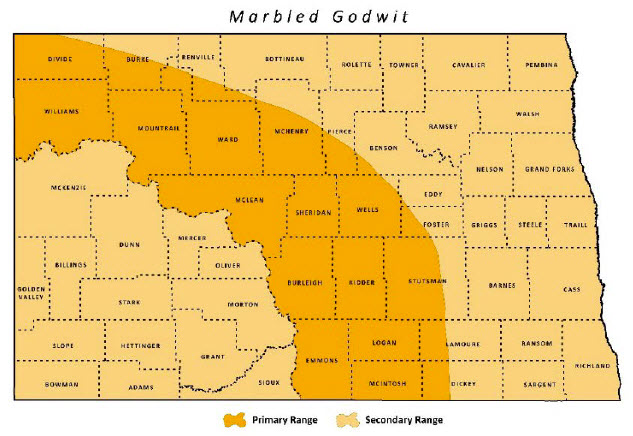
Marbled Godwit
| Scientific Name | Limosa fedoa |
|---|---|
| General Description | L 18”, WS 30”, 13 oz. Buff-brown, barring underneath, long up-turned, fleshcolored bill with a dark tip, and orangish underwings visible in flight. |
| Status | Occurs in North Dakota from mid-April to August. Peak breeding season occurs from early May to late June. |
| Abundance | Fairly common. |
| Primary Habitat | Forage in a variety of wetlands, nest frequently on grazed native prairie. |
| Federal Status | Migratory Bird. |
| Reason for Designation | It is estimated 70% of this species population breeds in the Prairie Pothole Region. It is included on the National USFWS Birds of Conservation Concern list, and also in Region 6, BCR 11 and 17. Watch List species in need of Management Attention in Shorebirds of Conservation Concern 2015. |
Locations and Conditions of Key Habitat
Preferred Habitat
Marbled Godwits require large expanses of short, sparse to moderately vegetated uplands for nesting. A high percentage of grass cover and a high number of wetlands is needed for high nest success. Prefer native grassland over tame, but will also use pastures, idle grasslands, and haylands. Nests in short grassy cover, so short they are usually not well concealed when sitting on the nest. Adults with broods will use taller, denser grass. Semipermanent, seasonal, and temporary wetlands with shallow water and little dense emergent vegetation are used for foraging. Also forage in the uplands, wet meadows, and roadside ditches. Primary prey items include insects, aquatic tubers, leeches, and small fish. Godwits are area sensitive, requiring blocks of grassland of at least 100 ha. Grazed or recently grazed uplands are often more attractive.
Key Areas and Conditions for Marbled Godwit in North Dakota
No specific sites have been identified. Most common in the Missouri Coteau and fairly common in the Drift Prairie and Missouri Slope, less common in the Red River Valley.
Problems Which May Affect this Species
Habitat
Conversion of grassland to cropland, energy development and urban expansion. Degradation of grasslands from invasive plants, woody encroachment, succession, and loss of diversity. Specifically, the loss of native prairie and associated wetlands is the greatest threat to Marbled Godwits in North Dakota.
Other Natural or Manmade Factors
Insecticides may decrease food availability. Mortality from vehicle and power line collisions. Early mowing can destroy nests or kill the adult on the nest. Expanding oil and gas development in North Dakota increases risk of oilfield contamination of wetland habitat.
Research and Survey Efforts
Current Research or Surveys
- Since 2004, the USFWS HAPET staff has coordinated a breeding shorebird survey in the Prairie Pothole Region of North and South Dakota. Surveys are conducted twice to correspond with the shorebird breeding season. Five grassland breeding shorebird species are targeted, including Marbled Godwit. Results from these surveys help guide grassland and conservation efforts.
Previous Research or Surveys
- The Nature Conservancy (ND SWG T-31-R) determined grassland bird response to decreased in grazing pressure in the Sheyenne River Delta area. The project was initiated in April 2011 and a final report provided in 2014. Marbled Godwit abundance was higher in recently burned areas, greater visual obstruction reading, and greater litter depth variability (Ahlering 2014).
- Ducks Unlimited (ND SWG T2-2-R) determined wetland occupancy by shorebirds in wind energy developments in the Prairie Pothole Region of North Dakota. The project was initiated in 2009 and a final report provided in 2011. Results indicate wind energy was probably not causing substantial reductions in shorebird occupancy, including Marbled Godwits. However, apparent presence of shorebirds was low and potential effects of wind development on shorebird populations needs further research and monitoring (Walker and Gleason 2011, Niemuth et al. 2013).
- Delta Waterfowl (ND SWG T-13-R) determined shorebird nest success and nest-site selection in northeast North Dakota. The project was initiated in 2005 and a final report provided in 2007. Vegetation surrounding shorebird nests was relatively short, sparse, native grass species. Shorebirds avoided sites dominated by invasive plants (e.g. leafy spurge, Canada thistle, Kentucky bluegrass, smooth brome, stinging nettle, and wormwood.) Habitat has a stronger impact on shorebird nest success than predator removal (Wiens 2007).
- Ducks Unlimited (ND SWG T-3-1 and T-8-R) determined demographic performance of prairie-nesting shorebirds in North Dakota. The project was initiated in 2004 and a final report provided in 2007. The highest reproductive success for shorebirds was in those areas with high amounts of grassland, low levels of edge between cropland and grassland, and high amount of wetland area. Preserving large intact grassland/wetland landscapes are key to safeguarding populations of Marbled Godwits (Stephens and Walker 2007).
- Fair number of published reports and gray literature on this species throughout its range.
Additional Research or Surveys Needed
Determine the effects of contaminants or insecticides on wetland quality and prey species.
Population and Trend Estimates

- North American Population Estimate 2012: 170,000
- North Dakota BBS Trend: see figure 22
- Survey-wide BBS Trend 1966-2012: -0.23
Management Recommendations
- Protect grassland/wetland complexes.
- Burn, mow, and graze grasslands to provide areas of shorter, sparser vegetation.
- Use rotational grazing rather than season-long, and avoid grazing until late May or late June.
- Remove trees from grasslands.
- On existing cropland, no-tillage and minimum-tillage processes can be less harmful to nesting godwits.
- Utility development should follow the guidance of “Reducing Avian Collisions with Power Lines” including marking power lines and creating an Avian Protection Plan.
Monitoring Plans
The Breeding Bird Survey continues to be a useful monitoring tool, however the annual surveys implemented by HAPET in 2004 are valuable. Ensuring all BBS routes are conducted annually is priority. A shorebird monitoring plan should follow The International Shorebird Survey (ISS) Program for Regional and International Shorebird Monitoring (PRISM) and “Guidance for Developing and Implementing Effective Shorebird Surveys.”
2005-2015 Progress
The Marbled Godwit remains a Level I Species of Conservation Priority. Several State Wildlife Grant Projects (T2-9-R, T2-11-HM, T-18-R, T-21-D, T-22-HM, T-23-HM, T-25-HM, T-27-HM, T-37-D) have contributed to habitat enhancement of wetlands and grasslands for Marbled Godwit and other wetland/grassland dependent birds.

Note: A listing of works consulted when compiling the information on this page may be found in the 2015 State Wildlife Action Plan.
